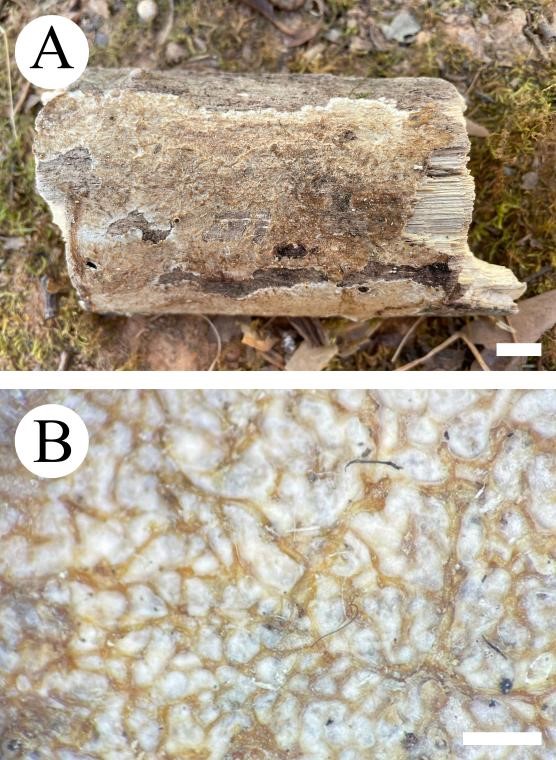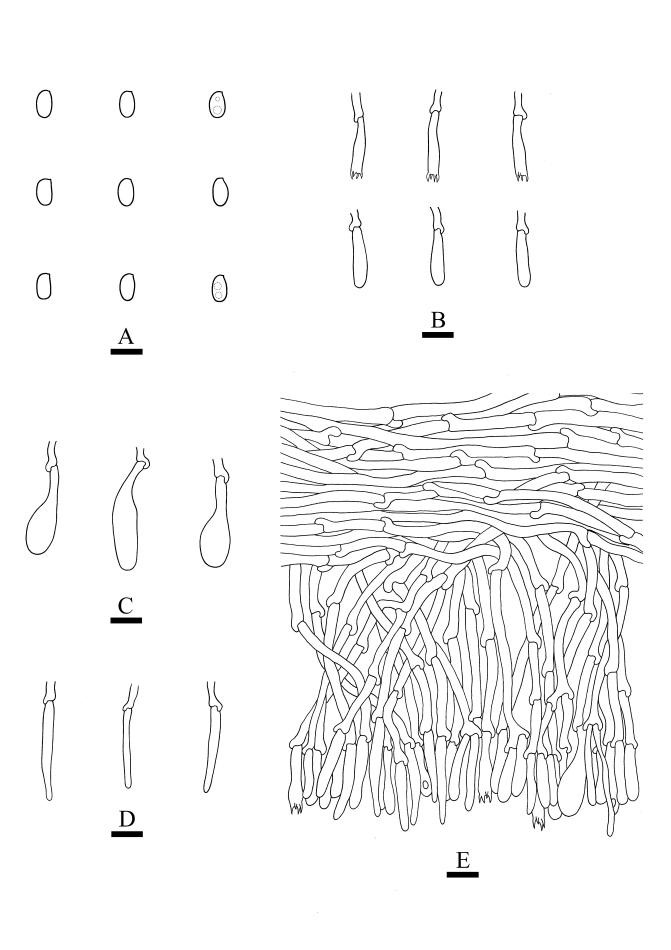Phlebia niveomarginata Authority.
MycoBank number: MB 843326; Index Fungorum number: IF 843326; Facesoffungi number: FoF 12692;
Description
Basidiomata annual, resupinate, ceraceous to subgelatinous, without odor or taste, when fresh, becoming coriaceous upon drying, up to 15 cm long, 6 cm wide, 300–500 µm thick. Hymenophore phlebioid, hymenial surface cream to greyish brown when fresh, greyish brown to brown upon drying. Sterile margin narrow, 1–2 mm wide, white. Hyphal structure monomitic; generative hyphae clamped at all primary septa, colorless, thin-walled, IKI–, CB–; tissues unchanged in KOH. Subicular hyphae unbranched, 3.5–6 μm in diameter; subhymenial hyphae infrequently branched, 2–4.5 μm in diameter. Hymenium cystidia pear-shaped, thin-walled, smooth, 25–29.5 × 7.5–10 μm; cylindrical cystidioles present, colorless, thin-walled, 20–29 × 2–4 µm; basidia cylindrical, with four sterigmata and a basal clamp connection, 16–22.5 × 2.5–4.5 µm. Basidiospores ellipsoid, colorless, thin-walled, smooth, IKI–, CB–, 3.7–4.7(–4.9) × (1.7–)1.8–2.5(–2.6) μm, L = 4.12 µm, W = 2.22 µm, Q = 1.81–1.88 (n = 60/2).
Material examined: China, Yunnan Province, Honghe, Pingbian County, Daweishan National Nature Reserve, E 102°06′, N 22°49′, alt. 1800 m, on a fallen branch of angiosperm, 9 Jun 2020, C.L. Zhao, CLZhao 19089 (SWFC).
Distribution: The species is known from Yunnan Province of China in a temperate forest area. It grows on small-sized and broad-leaved forest trees and provokes white rot.
Sequence data: ITS: MW732410 (ITS5/ITS4); LSU: MW724802 (LROR/LR7); GAPDH: ON892535 (GAPDH-F/GAPDH-R)
Notes: Phlebia niveomarginata clusters into Phlebia s.s., and it forms a single lineage, so we proposed it as a new species.

Fig. 1 Basidioma of Phlebia niveomarginata (holotype). — Scale bars: A = 1 cm, B = 1 mm.

Fig. 2 Microscopic structures of Phlebia niveomarginata (drawn from the holotype). A. Basidiospores; B. Basidia and basidioles; C. Cystidia; D. Cystidioles; E. A section of hymenium. — Scale bars: A = 5 μm, B–E = 10 μm.
